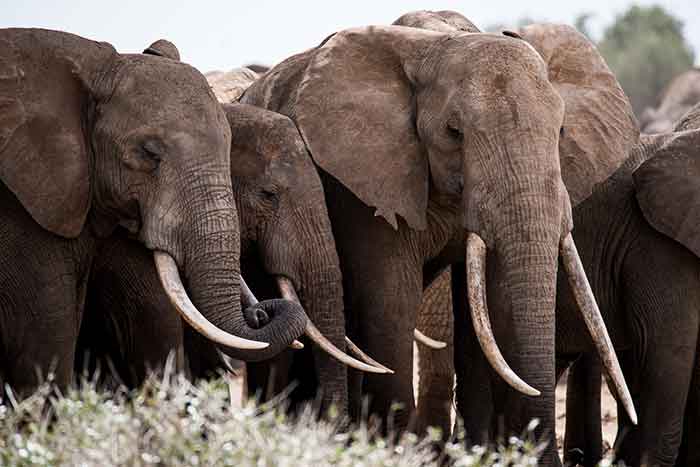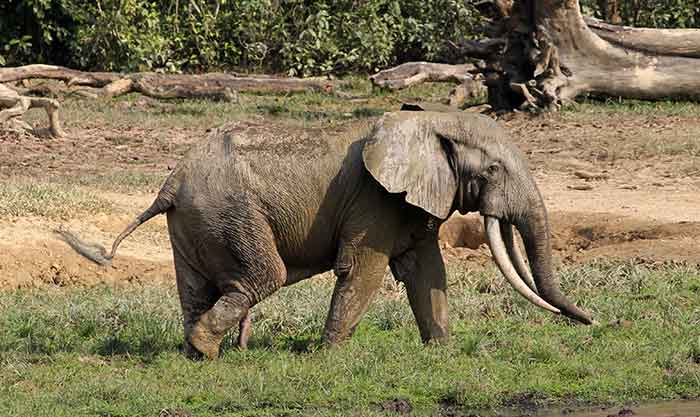
African Elephants are such magnificent animals that when the IUCN press-note popped up on my email, my heart plummeted to read that they are critically endangered and endangered.
The note attributes the decline over several decades due to poaching for ivory and loss of habitat. The African forest elephant is now listed as Critically Endangered and the African savanna elephant as Endangered on the IUCN Red List of Threatened Species. African elephants were treated as a single species, listed as Vulnerable; this is the first time the two species have been assessed separately for the IUCN Red List, following the emergence of new genetic evidence.
Our Indian species thankfully are safe for now with all the checks and balances in place, but the African Elephant has always been treading a fragile path with several issues, spiralling out of control, in the country.
“Africa’s elephants play key roles in ecosystems, economies and in our collective imagination all over the world. Today’s new IUCN Red List assessments of both African elephant species underline the persistent pressures faced by these iconic animals,” said Dr Bruno Oberle, IUCN Director General. “We must urgently put an end to poaching and ensure that sufficient suitable habitat for both forest and savanna elephants is conserved. Several African countries have led the way in recent years, proving that we can reverse elephant declines, and we must work together to ensure their example can be followed.”
The latest assessments highlight a massive decline in African elephant numbers across the continent. The number of African forest elephants fell by more than 86% over a period of 31 years, while the population of African savanna elephants decreased by at least 60% over the last 50 years, according to the assessments.
Both species suffered sharp declines since 2008 due to a significant increase in poaching, which peaked in 2011 and continues to threaten populations. The ongoing conversion of their habitats, primarily to agricultural and other land uses, is another significant threat. The 2016 IUCN African Elephant Status Report provides the most recent reliable estimate of the continental population of the two species combined, at around 415,000 elephants.

Despite the overall declining trend of both African elephant species, the assessments also highlight the impact of successful conservation efforts. Anti-poaching measures on the ground, together with more supportive legislation and land use planning which seeks to foster human-wildlife coexistence, have been key to successful elephant conservation. As a result, some forest elephants have stabilised in well-managed conservation areas in Gabon and the Republic of the Congo. Savanna elephant numbers have also been stable or growing for decades especially in the Kavango-Zambezi Transfrontier Conservation Area, which harbours the largest subpopulation of this species on the continent.
“While the results of the assessment place the continental population of savanna elephants in the Endangered category, it is important to keep in mind that at a site level, some subpopulations are thriving. For this reason, considerable caution and local knowledge are required when translating these results into policy,” said Dr Dave Balfour, assessor of the African elephants and member of the IUCN Species Survival Commission (SSC) African Elephant Specialist Group.
The decision to treat African forest and savanna elephants as separate species is the result of the consensus that has emerged among experts following new research into the genetics of elephant populations. Forest elephants occur in the tropical forests of Central Africa and in a range of habitats in West Africa. They rarely overlap with the range of the savanna elephant, which prefers open country and is found in a variety of habitats in Sub-Saharan Africa including grasslands and deserts. The forest elephant, which has a more restricted natural distribution, is thought to occupy only a quarter of its historic range today, with the largest remaining populations found in Gabon and the Republic of the Congo.
“For these assessments, a team of six assessors used data from as far back as the 1960s and a fully data-driven modelling approach to consolidate the decades-long efforts of many survey teams for the first time. The results quantify the dramatic extent of the decline of these ecologically important animals. With persistent demand for ivory and escalating human pressures on Africa’s wild lands, concern for Africa’s elephants is high, and the need to creatively conserve and wisely manage these animals and their habitats is more acute than ever,” said Dr Kathleen Gobush, lead assessor of the African elephants and member of the IUCN SSC African Elephant Specialist Group.
“We are proud to have supported almost 30% of the 6,218 assessments in this update, including assessments of underrepresented species such as trees, fungi and invertebrates,” said Masako Yamato, General Manager, Environmental Affairs Division of Toyota Motor Corporation. “This contributes to the growing diversity of species on the IUCN Red List, making it an increasingly powerful tool for guiding conservation in this important year for the Post 2020 Biodiversity Framework.”
There are scientific ways to help elephants survive like the variety of trees that the elephants require to survive.
“Just like us, elephants rely on trees and the ecosystem services they provide in order to survive. BGCI’s Global Tree Assessment (GTA) — the first global conservation assessment of all of the world’s known tree species, to be released later this year — will provide a roadmap for conserving the tree species and ecosystems upon which elephants, and species like them, depend,” said Dr Malin Rivers, Head of Conservation Prioritisation, Botanic Gardens Conservation International (BGCI).
“Regular re-assessment of a species’ status on the Red List helps to highlight worrying trends like what the elephants of Africa are experiencing. The health of our planet depends on the health of elephants and the ecosystems they inhabit, which is why Global Wildlife Conservation supports the Elephant Crisis Fund to get funding to groups across Africa working to save, recover, and manage elephant populations,” said Dr Barney Long, Global Wildlife Conservation’s Senior Director of Species Conservation.
If African Elephants are to survive the fact that so many groups have woken up to the catastrophe is heartening to note.
“These two Red List assessments reflect the outcome of the IUCN SSC African Elephant Specialist Group taking a bold, collaborative, evidence based decision to assess the African elephant as two separate species for the first time and understanding the implications and consequences of this shift. The outcome are robust assessments that provide users with the options to focus conservation efforts appropriately for the Critically Endangered forest elephant and the Endangered savanna elephant. It will be essential for IUCN SSC to engage with African range states and other agencies in dealing with the implications of the assessments,” said Dr Jon Paul Rodríguez, Chair of the IUCN Species Survival Commission.
Marianne Furtado de Nazareth – Former Assistant Editor, The Deccan Herald, Adjunct faculty – St. Joseph’s College, Mount Carmel’s College for Women and Jyoti Nivas College, Bangalore
GET COUNTERCURRENTS DAILY NEWSLETTER STRAIGHT TO YOUR INBOX














































